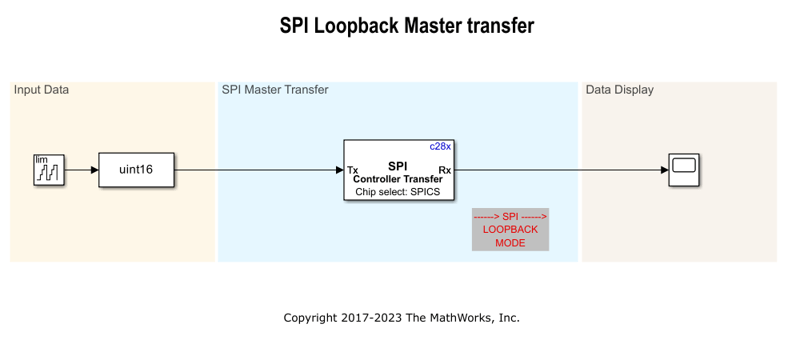C28x SPI Receive
Receive data through Serial Peripheral Interface (SPI) on target
Libraries:
C2000 Microcontroller Blockset /
C2802x
C2000 Microcontroller Blockset /
C2803x
C2000 Microcontroller Blockset /
C2805x
C2000 Microcontroller Blockset /
C2806x
C2000 Microcontroller Blockset /
C280x
C2000 Microcontroller Blockset /
C281x
C2000 Microcontroller Blockset /
C2833x
C2000 Microcontroller Blockset /
C2834x
C2000 Microcontroller Blockset /
F280013x
C2000 Microcontroller Blockset /
F280015x
C2000 Microcontroller Blockset /
F28002x
C2000 Microcontroller Blockset /
F28003x
C2000 Microcontroller Blockset /
F28004x
C2000 Microcontroller Blockset /
F2807x
C2000 Microcontroller Blockset /
F2837xD
C2000 Microcontroller Blockset /
F2837xS
C2000 Microcontroller Blockset /
F2838x /
C28x
C2000 Microcontroller Blockset /
F28M35x /
C28x
C2000 Microcontroller Blockset /
F28M36x /
C28x
C2000 Microcontroller Blockset /
F28p65x
C2000 Microcontroller Blockset /
F28p55x
Embedded Coder Support Package for STMicroelectronics STM32 Processors /
STM32F4xx Based Boards
Embedded Coder Support Package for STMicroelectronics STM32 Processors /
STM32F7xx Based Boards
Embedded Coder Support Package for STMicroelectronics STM32 Processors /
STM32G4xx Based Boards
Embedded Coder Support Package for STMicroelectronics STM32 Processors /
STM32H7xx Based Boards
Embedded Coder Support Package for STMicroelectronics STM32 Processors /
STM32L4xx Based Boards
Embedded Coder Support Package for STMicroelectronics STM32 Processors /
STM32L5xx Based Boards
Embedded Coder Support Package for STMicroelectronics STM32 Processors /
STM32U5xx Based Boards
Embedded Coder Support Package for STMicroelectronics STM32 Processors /
STM32WBxx Based Boards
Description
The SPI Receive block supports synchronous, serial peripheral input/output port communications between the processor and external peripherals or other controllers. The block can run in either peripheral or controller mode. In controller mode, the SPISIMO pin transmits data, and the SPISOMI pin receives the data. When controller mode is selected, the SPI initiates the data transfer by sending a serial clock signal (SPICLK), which is used for the entire serial communications link. Data transfers are synchronized to this SPICLK, which enables both controller and peripheral to send and receive data simultaneously. The maximum frequency for the clock is one quarter of the processor clock frequency.
The SPI device receives data and places the data in the receive buffer. The SPI Receive block reads the data from the receive buffer. In controller mode, the C28x SPI Transmit block initiates SPI transmission by writing data to the transmit buffer. Then, the data received in the receive buffer is read by the SPI Receive block. In peripheral mode, the SPI Receive block is used to read the data in the receive buffer, which is received from the controller. Then, the data is written into the transmit buffer using the SPI Transmit block. From the transmit buffer, the data is sent to the controller.
Note
To communicate with multiple peripherals using the same SPI module, use multiple instances of the SPI block with the same module and configure a unique chip select for each instance.
Configure the SPI modules for a specific hardware board by navigating to Hardware Implementation > Target hardware resources. Verify that these settings meet the requirements of your application.
Examples
Ports
Output
Parameters
Extended Capabilities
Version History
Introduced in R2017b
